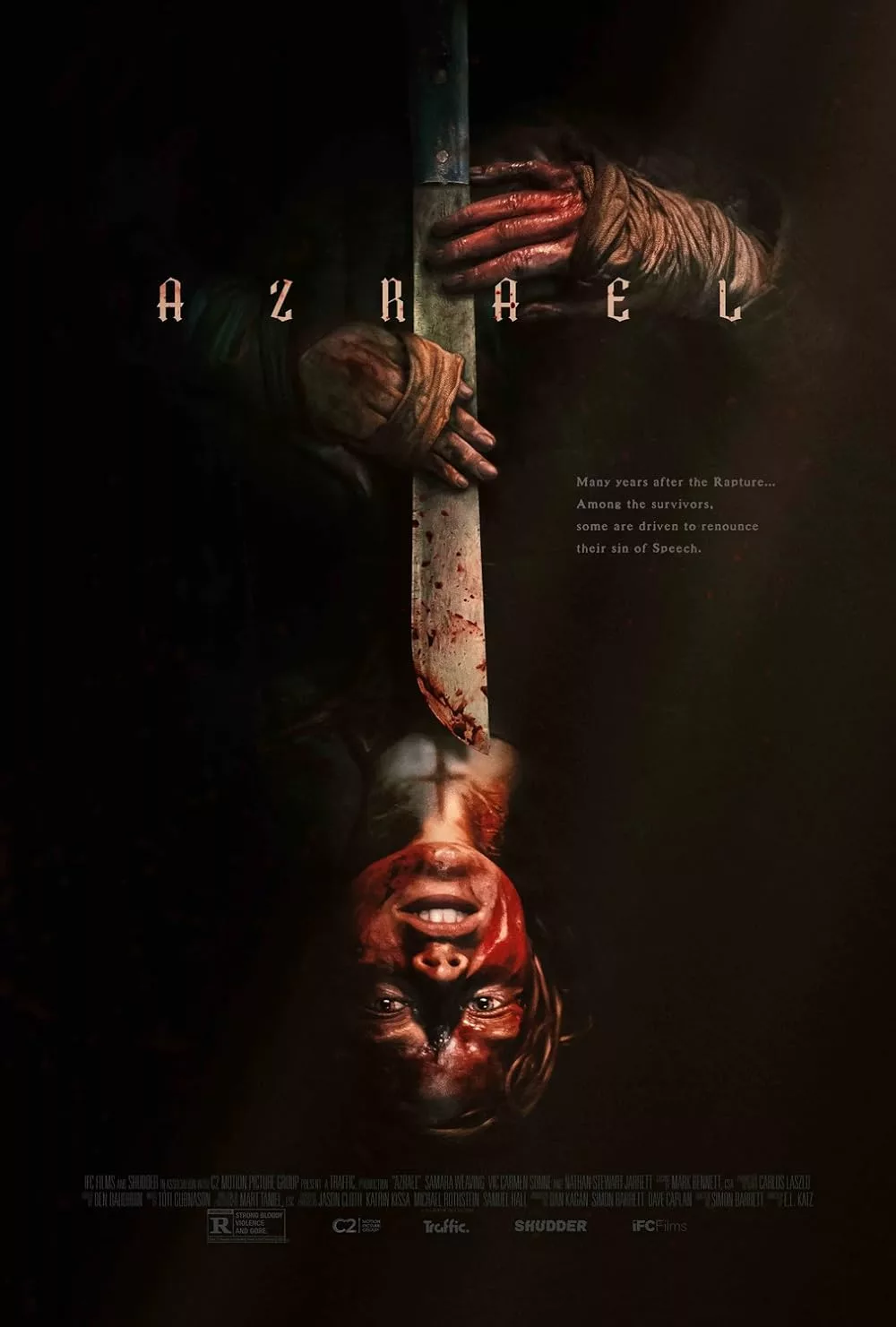The terrors are few in E.L. Katz’s tepid horror thriller “Azrael.” We are plunged headfirst into a forest, where a young woman and man appear in love, if occasionally frustrated with each other. Neither can speak, so their story is told entirely by looks and affectionate gestures. But something is off in their world. There is a danger that is attracted to noise and motion, so silence and stillness are essential to one’s survival. Their idyllic woodsy bliss is interrupted when other humans capture them for an untold plot. They, too, cannot speak. As the terrors close in on all sides, Azrael (Samara Weaving) must take matters into her own hands and fight for her survival.
Weaving, who broke out with the fantastic all-out-family-feud hit “Ready or Not,” is placed in a similar “me against the world” predicament and must claw her way back to safety. Unfortunately, the story from writer and co-producer Simon Barrett gives her very little to work with beyond looking scared and struggling. It’s chase sequence after chase sequence with hints of context here and there, just enough to hold the story together but not enough to fully explain everything. Unlike Azrael, her partner Kenon (Nathan Stewart-Jarrett) is, unfortunately, mere emotional bait, and he functions like an afterthought once off-screen.
Like the mythical Azrael (a nod to the angel of death), the film incorporates other religious motifs and references, especially in the encampment where a church houses a Mary-like figure named Miriam (Vic Carmen Sonne) whose second-in-command is a woman named Josefine (Katariina Unt). The walls are lined with crude paintings and candles, but its main purpose seems to reaffirm Miriam’s domination of the group as a cult leader. She’s the only character all clad in crisp white linen while the rest survive in grungy clothes the color of the forest earth, elevating her status in her small fiefdom. Why she and Josefine want Azrael so badly to be sacrificed to the monsters remains a mystery. Is it supposed to be a virgin sacrifice? Or does Azrael represent a danger to Miriam that only she knows? These are just some of the unsolved mysteries left unanswered.
There are some clues in the movie’s references to other horror classics, like how the title crawls up on the screen, reminiscent of Stanley Kubrick’s “The Shining” or how Miriam’s pregnancy resembles Roman Polanski’s “Rosemary’s Baby.” The most obvious example is John Krasinski’s “A Quiet Place,” where the lack of sound and dialogue is a creative challenge. Katz does not quite manage to sustain the same level of suspense, and much feels lost in the lack of dialogue or any semblance of communication. Some moments captured by cinematographer Mart Taniel look like an entrancing reprieve like a shot where the daylight pours into the forest through the leaves and car lights illuminate trees in pure darkness, but they are too short to savor for long. Other scenes feel quite predictable, filmed in such a way that nothing felt particularly haunting, and only memorable when the movie’s monsters feast on the poor souls unlucky enough to get caught.
Speaking of those monsters, the demonic apparitions look like burnt bodies fresh out of hell, charred to a crisp black yet moist from protruding deep red muscles and blood where skin no longer exists. It’s a gruesome sight but not necessarily a scary one when the logic of these creatures seems only to suit the story’s needs. At the film’s start, Azrael panics because her partner started a fire, but later, the encampment feels quite secure in openly burning fires for light. Sure, they’re flimsy barricades, but isn’t that tempting fate to lure these creatures? The figures slowly walk like zombies, unsteadily careening towards their prey with an unsteady gait, but then they can switch to an all-out sprint to chase after a target on the move. They smell and follow blood and noise, but like the T-Rex in “Jurassic Park,” they can’t see someone if they don’t move, yet other times, they can. The inconsistencies keep the viewer guessing, and not in a good way.
Ultimately, “Azrael” lacks the energy or chills to terrify viewers. The setting where the story takes place is strange but befuddling, mixing religion and horror in the hopes of scaring the audience. Instead, the film merely strikes an ominous mood, like a poorly-executed haunted house. Text in between scenes does little to connect one moment to the next, so for most of the movie, your mind fills in the script’s blanks, which can feel more laborious than enjoyable. This “A Quiet Place” riff doesn’t do enough to set itself apart and fails to frighten its audience with anything they haven’t seen before.




















